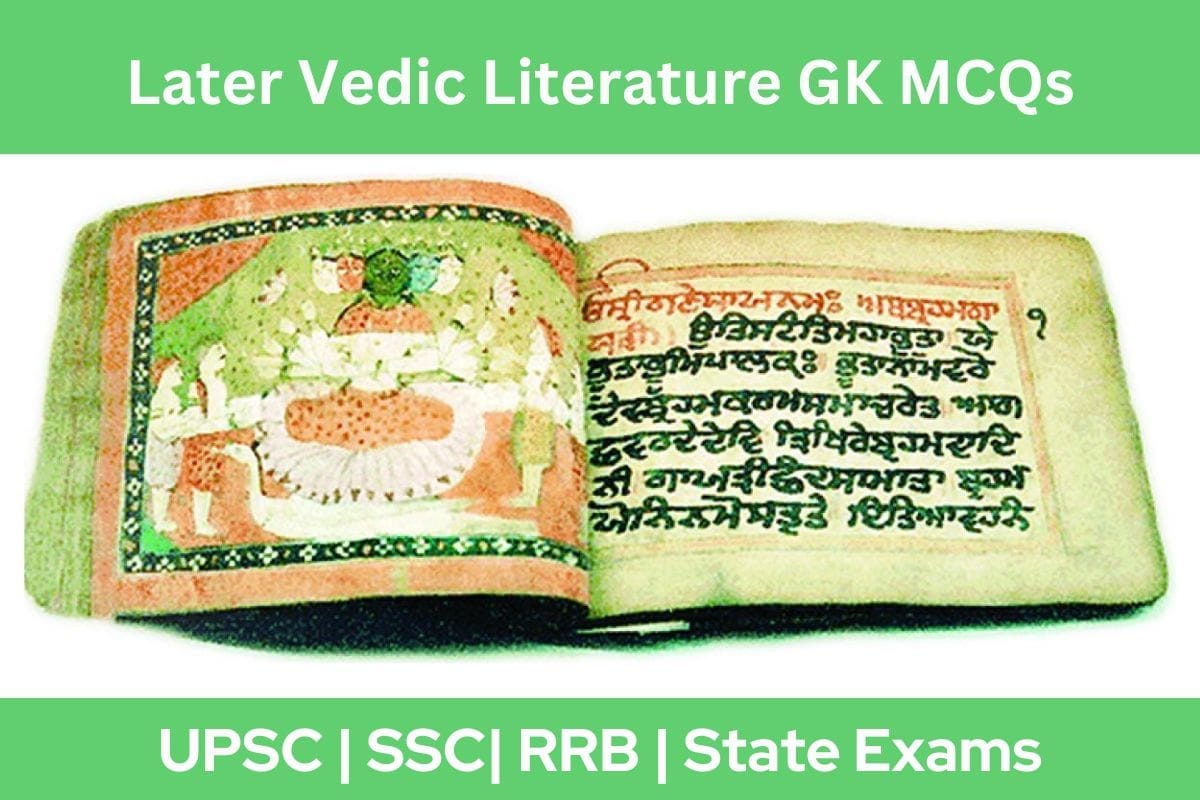
Later Vedic Literature GK MCQs With Answer & Explanation in English represents a significant phase in ancient Indian literary and cultural development. This set of 10 Multiple Choice Questions (MCQs) with answers and explanations is tailored for government job comparative exams. Explore the rich literary heritage of the Later Vedic period through these questions designed to enhance your understanding of this historical epoch.
1. The institution of gotra appeared in which of the following periods?
- Rig Vedic Age
- Later Vedic Age
- Mauryan Age
- Satavahana period
Show Answer
Correct Answer: Later Vedic Age
The institution of gotra, originally referring to a place where cattle were kept, appeared during the Later Vedic period. Its meaning evolved to signify “descent from a common ancestor,” forming the basis for family and clan identity.
2. The Later Vedic culture is also called:
- Calcholithic culture
- Painted grey ware culture
- Painted red ware culture
- Bronze age
Show Answer
Correct Answer: Painted grey ware culture
The Later Vedic culture is often referred to as the Painted Grey Ware culture, named after the type of pottery known as painted grey ware that was prevalent during this period. It is a distinctive archaeological marker of this era.
3. Ayas referred to which of the following during the Rig Vedic period?
- Either copper or bronze
- Either iron or steel
- Either tin or iron
- Either gold or silver
Show Answer
Correct Answer: Either copper or bronze
In the Rig Vedic period, the term “ayas” referred to a metal, either copper or bronze. Iron was introduced during the Later Vedic period, signifying technological advancements in metallurgy.
4. During the Later Vedic age, the collection of taxes and tributes was done by which of the following?
- Sangrihitri
- Senani
- Kulapati
- Grahpati
Show Answer
Correct Answer: Sangrihitri
During the Later Vedic age, the collection of taxes and tributes was carried out by officers known as Sangrihitri. These officials were responsible for collecting taxes from the Vaishyas, who were the primary tribute payers during this period.
5. Which of the following emerged as the chief means of livelihood for the Later Vedic people?
- Fishing
- Hunting
- Agriculture
- Rearing animals
Show Answer
Correct Answer: Agriculture’
Agriculture became the primary means of livelihood during the Later Vedic period. Forest areas were cleared by burning trees, and ploughs were used for cultivation, reflecting advancements in agricultural practices.
6. Which of the following is the term used for the head of the household who owned the land during the Later Vedic period?
- Grihapati
- Godhuma
- Shresthins
- None of the above
Show Answer
Correct Answer: Grihapati
Although land was still communally owned during the Later Vedic period, the head of the household who owned the land was known as the Grahpati, indicating shifts in land ownership and management.
7. Which of the following was the staple diet of the people during the Later Vedic period?
- Lentils
- Tila
- Godhuma
- None of the above
Show Answer
Correct Answer: Godhuma
Rice (Vrihi) and wheat (Godhuma) became staple dietary items during the Later Vedic Age. Lentils were also grown, and cooked rice was often included as part of dana (donations) and dakshina (offerings) in religious and social contexts.
8. Which of the following explains the term ‘shreni’?
- A religious group
- A committee to advise the king
- Guilds or organizations of merchants
- None of the above
Show Answer
Correct Answer: Guilds or organizations of merchants
The term ‘shreni’ referred to guilds or organizations of merchants during the Later Vedic period. These guilds played a significant role in economic activities, trade, and commerce, reflecting the growing complexity of society.
9. Which of the following gods became supreme during the Later Vedic Age?
- Indra
- Agni
- Prajapati
- Vishnu
Show Answer
Correct Answer: Prajapati
During the Later Vedic period, there was a shift in the prominence of gods in the religious belief system. Indra and Agni lost their prominence, and Prajapati, the creator god, became supreme in the pantheon.
10. Who was ‘rathakara’?
- Chariot makers
- Weaver
- Handicraftsmen
- Smelters
Show Answer
Correct Answer: Chariot makers
Rathakara’ referred to chariot makers during the Later Vedic period. These artisans held a high social status and were even entitled to the sacred thread ceremony, highlighting their importance in society.
Read Daily Current Affairs



Leave a Reply